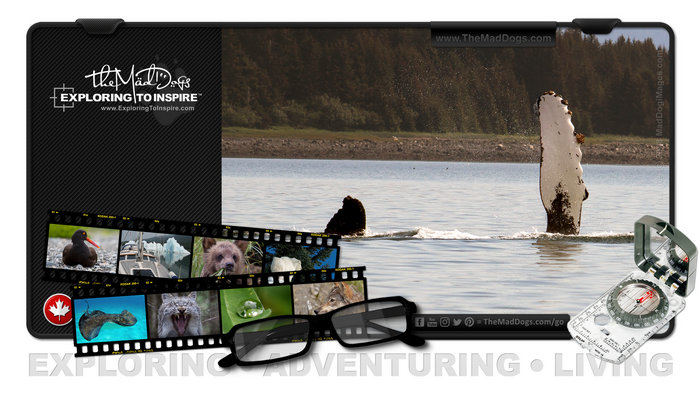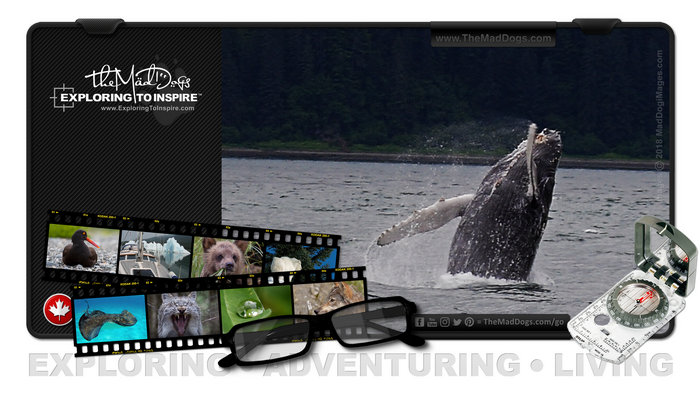Welcome to Canadian Wildlife
--
The
wild side of Canada™ |
Copyright notice: All text, layout,
images and graphical representations are copyright ©
2010
Mad Dog
Digital and may not be copied, reproduced or
transmitted without the written consent of
Mad Dog
Digital. Please contact us for more
information |
|
|
-- |
|
Details about:
Humpback
Whales |
 The
Humpback Whales The
Humpback Whales
Humpback Whales are one of the most sought after
tourist sights in Alaska and the Canadian waters
along the BC coast.
Although growing to enormous sizes, Humpback whales
are relatively gentle and docile creatures. Humpback
Whales average 40 - 52 ft (12 - 16 m) in length,
weigh approx 79,000 lb (36,000 kg) and survive by
eating massive amounts of krill, plankton and small
schooling fish. The largest recorded Humpback
specimen measured 62 ft (19 m) long, and had
pectoral fins 20 ft (6 m) long. |
| |
 |
| |
The Humpback Whale is a rorqual whale that also
includes other baleen whales. Rorqual whales have a
"pleated" style throat that can expand to several
times the original volume when a whale takes a
(huge!) mouthful of saltwater and prey-food
(consisting of krill, small fish and plankton).
Using its tongue, the saltwater is strained out
through the baleen leaving the whale with a mouthful
of tasty treats.
A baleen, or baleen plate, is a plate of thick
structures made of keratin (the same material as
hair and nails) hanging down from the upper jaw.
With a mouth and throat full of water & food, they
push the water out through the baleen, using it like
a strainer to let the water out and keep the food
inside |
| |
 |
| |
A Humpback Whale can be identified by a short dorsal
fin, large pectoral fins (flippers) and groups of
knobblies on their faces. Each individual Humpback
Whale can be further identified by the black & white
markings on the underside of the tail fin & pectoral
fins. Like fingerprints, the coloration and patterns
are unique to each whale and remain stable with
little variance, throughout the whales life.
One outstanding feature of the Humpback Whale is the
large pectoral fins. Even when first classified, it
was these large pectoral fins that categorized the
Humpback Whale in its own genus grouping called "Megaptera"
meaning "huge-wings". |
| |
 |
| |
The Humpback Whale received it's name based on the
motion of it's body as it surfaces and dives back
under water, arching its back in a hump. During a
diving sequence, a Humpback Whale surfaces, breathes
(making a "V" shaped blow up to 10 ft (3 m) high)
through its pair of blow holes, arches its back and
flips its tail out of the water on the way down. A
Humpbacks' tail can account for up to 1/3 of the
body length and may measure up to 12' (4 m) wide on
large animals.
Once underwater a Humpback Whale may stay submerged
for up to 30 minutes, but usually average only 15
minutes, and may dive down 500 - 700 ft (150 - 210
m).
The "knobblies" on a Humpback Whales head and around
its jaw are an evolved form of a hair follicle
called a "tubercle". Each tubercle has a bristly
“hair” growing out of it. It is in these areas that
barnacles attach themselves, spending their lives
getting a free ride and cruising the oceans. |
| |
 |
| |
4 separate groups of Humpback groups have been
identified, with 3 of those being migratory. Of the
migratory Humpback Whale groups, one group lives in
the Pacific Ocean, one in the northern Atlantic and
the third travels the southern waters. It is the
Humpback Whales of the Indian Ocean are the only
group that does not migrate to cooler feeding
waters.
Humpback Whales seen in the Pacific Northwest,
including Alaska, and the BC coast in Canada make
incredible migratory journeys every year. After
spending an entire summer in the Pacific Northwest
gorging themselves in the nutrient rich waters, they
begin a migration of up to 8,000 mile (12,800 km).
Alternating locations for the migration include the
warm tropical waters of Hawaii and Mexico.
While spending the winter in the warm tropical
waters, pregnant Humpback Whales give birth to giant
baby Humpbacks. Measuring as long as their mothers
head, an average of 15 ft (4.5 m), they weigh
between 2,000 - 4,000 lbs (900 - 1800 kg) and may
consume up to 100 lbs (45 kg) of milk per day. The
calves stay with the mother as they migration takes
them back to the nutrient rich northern waters.
Feeding exclusively on mothers' milk for the first
six months of its life, the calf spends the next 6
months on a mixture of mothers’ milk and solid food. |
| |
 |
| |
While in the northern waters of Alaska and Canada,
Humpback Whales consume tremendous amounts of food.
They generally feed twice a day and may consume up
to 4,500 lbs (2,000 kg) of seafood everyday.
Approximately 120 days are spent in the northern
waters before starting the migration to warm waters
all over again.
Once in the warm tropical waters whales do not eat
but rely on their fat deposits to carry them over.
After a winter of courtship and mating, during which
time the males "sing" long eerie sounding songs that
may last days at a time, spring signals the start of
the migration to the cooler northern waters. Glacier
Bay is a summer home to many humpback whales as many
of the same whales have been recognized year after
year.
Humpback Whales use various feeding techniques to
eat krill, plankton & small schooling fish such as
herring, capelin. Bubble feeding - blowing declining
spiral rings to coral prey closer together to be
swallowed as once, is a common technique. While they
generally bubble-feed as a group, it has been known
to be done by a single animal as well.
Humpback Whales are a popular attraction for Whale
Watching tours as they are very curious and
acrobatic animals. A favorite attraction is the
display of great strength, a full-grown humpback
will breach (launch themselves almost clear out of
the water) and splash down with a great explosion of
water.
Return to our main animals in
Canada page |
| |
Thanks for stopping by our website Canadian
Wildlife!
 |
| |
|
|
|



